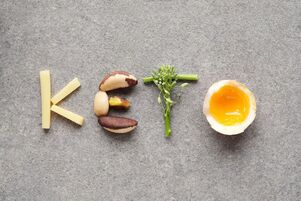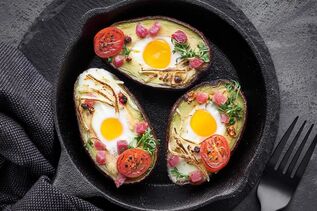The keto diet is not the easiest diet for beginners. Since keto is almost completely carbohydrate restrictive, choosing a variety of protein options isn't always easy. However, the main goal of this diet is precisely to give up carbohydrates, which helps to lose weight.
Below in the material we will find an example of a daily keto diet - detailed menus will help you eat not only healthy, but also delicious. Also, we'll tell you about the rules for getting into a ketone diet - it's especially important for beginners to switch to a multi-step carb-free diet.
What is the keto diet?

The keto diet is a diet plan that involves avoiding carbohydrates. The mechanism of the keto diet is based on the fact that when carbohydrates are excluded, a person's blood glucose level drops and the body enters a ketogenic regime - in this case, free fatty acids and fat stores become themain source of energy.
The advantage of the keto diet is to lose weight quickly without calorie control. Studies show that the ketogenic diet shows the best long-term results - that is, with its help, you can not only burn fat, but also maintain the achieved shape for a long time.
However, the keto diet has contraindications. First, it is prohibited for pregnant and lactating women, as well as adolescents. Secondly, such a diet is not combined with insulin injections for diabetes or hypertension. Thirdly, for some chronic diseases.
Daily meals
For beginners on the keto diet, it is recommended that you cut out fast carbs completely. That said, if you've never tried a carb-free diet before, spend the first 7-10 days changing your eating habits to minimize the simple carbohydrates in your diet. The egg diet is also suitable for beginners.
If you are already familiar with the method of limiting carbohydrates in your diet, the easiest way to enter the keto diet is intermittent fasting, for example according to the scheme 16/8. Follow this regimen for at least 5-7 days to lower your blood glucose levels and make it easier for you to progress to full ketosis. It is important for beginners to take their time.
I don't understand at all why so many bad things are written on this power system? I am 32 years old and have always loved sweets. Just to tremble. As a result, I was afraid for my health. I have been eating keto for 2 months and this is the best thing that has happened to me! The energy just went off the scale, I was able to work until 12 and get up at 6. I lost 13 kg and I didn't count calories at all, I wasn't hungry and there are many recipes with allowed foods.
Keto food - what can you eat?

The keto diet allows you to eat only foods that do not contain carbohydrates. They do not raise blood sugar levels and keep the body out of fat burning ketosis. Flour products, sweets, fruit, juice and soda are completely prohibited. Also, potatoes and other starchy vegetables can't be eaten on keto.
List of allowed Keto foods:
- all types of meat (beef, pork, chicken);
- all types of fish and seafood;
- chicken eggs;
- dairy products (butter, cheese, natural ricotta, milk in small quantities);
- any vegetable oil;
- any green vegetables;
- nuts in small quantities;
- berries in small quantities;
- non-starchy vegetables (avocado, pumpkin in small quantities);
- herbs, seeds (including chia seeds), spices
- mushrooms.
Rules for eating keto
One of the rules of the keto diet is to consume lots of pure water every day. This helps reduce the negative effects of the diet (in particular, digestive difficulties and the smell of acetone from the mouth). It is also necessary to monitor the amount of salt in the diet.
We mention separately the need to control the consumption of alcoholic beverages. The keto diet can increase the level of ammonia in the blood - along with the use of alcohol, this can lead to toxic liver damage. It is for the same reason that the ketone diet is contraindicated in liver and kidney diseases.
Weekly Keto Diet - Daily Menu
To avoid vitamin deficiencies following the keto diet, it is necessary to include in the daily diet tomatoes, green vegetables and fruits with a minimum amount of carbohydrates (various berries, as well as citrus fruits). In turn, nuts will be a good source of minerals: peanuts and walnuts, pine nuts or any other.

To avoid vitamin deficiencies following the keto diet, it is necessary to include in the daily diet tomatoes, green vegetables and fruits with a minimum amount of carbohydrates (various berries, as well as citrus fruits). In turn, nuts will be a good source of minerals: peanuts and walnuts, pine nuts or any other.
The calorie content of the ketogenic menu below is 1300 kcal. per day, which is suitable for women who wish to lose weight with a low level of physical activity. For men, the calories and portions should be increased.
1 day of Monday
- Breakfast:2 eggs, 10g butter, half an avocado, coffee or tea without milk and sugar.
- Second breakfast:a portion of sugar-free ricotta (15 g).
- Lunch:fish (120g fillet) with broccoli and 6 cherry tomatoes, green tea.
- Snack:1 sugar-free jelly and a handful of berries.
- Dinner:chicken breast (120g) with olive oil (10ml) and mustard (10ml). Salad: 3 large lettuce leaves, 1 cucumber, half a lemon and grated cheese.
Carbohydrates: 24 g, Protein: 75 g, Fat: 96 g
2nd day Tuesday
- Breakfast:2 eggs with bacon, keto coffee.
- Second breakfast:jelly without sugar.
- Lunch:fried meat (120 g) with rocket salad, zucchini and half an avocado; green tea.
- Snack:a handful of strawberries or other berries.
- Dinner:fried chicken fillet with mushrooms, fresh leaf salad, half a tomato and cucumber with 10 ml of olive oil; 1/2 cup of blueberries
Carbohydrates: 29 g, Protein: 80 g, Fat: 99 g
3 days of Wednesday
- Breakfast:2 hard-boiled eggs, a slice of cheese and 2 spinach leaves; coffee with 10 ml of milk cream or coconut milk.
- Second breakfast:unsweetened yogurt, a handful of berries.
- Lunch:salad with tuna and fresh cabbage, sesame dressing and soy sauce.
- Snack:2 pieces of dark chocolate without sugar (at least 75% cocoa).
- Dinner:chicken breast with mushrooms, 50 g of pumpkin, salad with tomato and olives.
Carbohydrates: 34 g, Protein: 88 g, Fat: 101 g
4th day Thursday
- Breakfast:green smoothie with spirulina (10 g) and chia seeds (15 g); slicing cheese and ham.
- Second breakfast:a handful of nuts.
- Lunch:Baked avocado with egg, bacon and cheese. Rocket, cabbage and cucumber salad.
- Snack:sugar-free yogurt.
- Dinner:a glass of bone broth, spinach tortillas (3 eggs, half a cup of spinach, 10 g of butter).
Carbohydrates: 29 g, Protein: 80 g, Fat: 110 g
5th day Friday
- Breakfast:scrambled eggs and half a tomato, coffee or tea.
- Second breakfast:a handful of nuts, 2 pieces of dark chocolate.
- Lunch:fillet of beef with mushrooms and spinach, green tea.
- Snack:150 g of melon and 10 g of coconut.
- Dinner:salad of tomatoes, canned tuna, cucumbers and olives, dressed with lemon.
Carbohydrates: 39 g, Protein: 76 g, Fat: 108 g
6th day Saturday
- Breakfast:sliced ham and cheese, green tea.
- Second breakfast:2 hard-boiled eggs.
- Lunch:100 g of stewed shrimp with courgettes, olive oil, cheese and rocket.
- Snack:jelly without sugar.
- Dinner:baked fish with eggplant caviar.
Carbohydrates: 34 g, Protein: 79 g, Fat: 99 g
Seventh day Sunday
- Breakfast:scrambled eggs and bacon.
- Second breakfast:cottage cheese without sugar, a handful of berries.
- Lunch:Chicken stew with cabbage, mushrooms and sesame seeds.
- Snack:2 pieces of dark chocolate, nuts.
- Dinner: fish soup with pumpkin (50 g) and fried tomatoes.
Carbohydrates: 38 g, Protein: 88 g, Fat: 102 g
The keto diet is a diet with a maximum restriction of carbohydrates. For beginners on this diet, the most difficult are the first days, when the body is rebuilt in ketosis - dizziness and weakness can be observed. In the future, the metabolism changes and the body gets used to working in a fat-burning mode without carbohydrates.




















